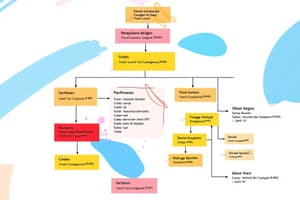Podcast
Questions and Answers
What does a Software class represent?
What does a Software class represent?
- A specific implementation in an object-oriented language
- A specification or perspective of a software component (correct)
- A general overview of project management techniques
- A tool for generating automated tests
Which of the following statements is true regarding UML 2?
Which of the following statements is true regarding UML 2?
- UML 2 was a minor update with minimal changes.
- UML 2 includes revisions based on input from key members of the specification team. (correct)
- UML 2 is mainly focused on data modeling techniques.
- UML 2 is not widely used in modern software engineering.
What is the primary focus of the initial chapters before OOA/D?
What is the primary focus of the initial chapters before OOA/D?
- Implementation strategies using Java
- Use cases and requirements analysis (correct)
- Detailed algorithm design techniques
- Theoretical concepts of software engineering
Why is visual modeling considered beneficial?
Why is visual modeling considered beneficial?
What does a UML class diagram represent in the conceptual perspective?
What does a UML class diagram represent in the conceptual perspective?
Who is credited with coining the terms 'object-oriented programming' and 'personal computing'?
Who is credited with coining the terms 'object-oriented programming' and 'personal computing'?
What is the primary focus of the specification perspective in UML class diagrams?
What is the primary focus of the specification perspective in UML class diagrams?
In what decade did Alan Kay begin his work on object-oriented programming?
In what decade did Alan Kay begin his work on object-oriented programming?
Which of the following best describes UML class terminology in the raw UML?
Which of the following best describes UML class terminology in the raw UML?
What did UML diagrams help to explore in software analysis?
What did UML diagrams help to explore in software analysis?
What term is used to refer to UML boxes in the Domain Model according to the UP?
What term is used to refer to UML boxes in the Domain Model according to the UP?
What is OOA/D typically preceded by?
What is OOA/D typically preceded by?
What does the Implementation perspective in UML class diagrams focus on?
What does the Implementation perspective in UML class diagrams focus on?
What does a design class diagram typically illustrate?
What does a design class diagram typically illustrate?
How does a design class diagram differ from a domain model?
How does a design class diagram differ from a domain model?
Why is the specification perspective seldom used for design in UML?
Why is the specification perspective seldom used for design in UML?
What distinction is made between conceptual and design classes in UML?
What distinction is made between conceptual and design classes in UML?
Which of the following methods would typically be found in the Die class, based on a design class diagram for a dice game?
Which of the following methods would typically be found in the Die class, based on a design class diagram for a dice game?
Which of the following is true about the UML class notation?
Which of the following is true about the UML class notation?
What role does the DiceGame object play in the sequence diagram of the dice game?
What role does the DiceGame object play in the sequence diagram of the dice game?
What is a key purpose of interaction diagrams like sequence diagrams in object-oriented design?
What is a key purpose of interaction diagrams like sequence diagrams in object-oriented design?
Which method would NOT typically be associated with the DiceGame class based on its role in the game?
Which method would NOT typically be associated with the DiceGame class based on its role in the game?
In object-oriented design, what is the primary function of the attributes in a design class diagram?
In object-oriented design, what is the primary function of the attributes in a design class diagram?
Why is it important that OO designs maintain a lower representational gap?
Why is it important that OO designs maintain a lower representational gap?
Flashcards
Conceptual Perspective
Conceptual Perspective
A UML diagram that describes things in the real world or a specific domain of interest.
Specification Perspective
Specification Perspective
A UML diagram that describes software abstractions or components with specifications and interfaces, but without specific technology or implementation details.
Implementation Perspective
Implementation Perspective
A UML diagram that describes the exact implementation of software elements in a specific programming language or technology.
Classifier
Classifier
Signup and view all the flashcards
Conceptual Class
Conceptual Class
Signup and view all the flashcards
Design Class
Design Class
Signup and view all the flashcards
Meaning of 'Class'
Meaning of 'Class'
Signup and view all the flashcards
Unified Process (UP)
Unified Process (UP)
Signup and view all the flashcards
Sequence Diagram
Sequence Diagram
Signup and view all the flashcards
Design Class Diagram
Design Class Diagram
Signup and view all the flashcards
Domain Model
Domain Model
Signup and view all the flashcards
Object Responsibilities
Object Responsibilities
Signup and view all the flashcards
Interaction Diagrams
Interaction Diagrams
Signup and view all the flashcards
Software Object Method
Software Object Method
Signup and view all the flashcards
Representational Gap
Representational Gap
Signup and view all the flashcards
Object-Oriented Design
Object-Oriented Design
Signup and view all the flashcards
Software Class
Software Class
Signup and view all the flashcards
Implementation Class
Implementation Class
Signup and view all the flashcards
UML 2
UML 2
Signup and view all the flashcards
Visual Modeling
Visual Modeling
Signup and view all the flashcards
Object-Oriented Analysis and Design (OOA/D)
Object-Oriented Analysis and Design (OOA/D)
Signup and view all the flashcards
Use Cases
Use Cases
Signup and view all the flashcards
Requirements Analysis
Requirements Analysis
Signup and view all the flashcards
Study Notes
UML and Object-Oriented Design
- UML can represent real-world concepts, software classes, or implementation details.
- The same notation (like UML class diagrams) can visualize different aspects (conceptual, specification, implementation) of a system.
- The UML concept of "class" applies broadly to many things (real-world, software).
- Modern UML (UML2) is used in this text.
UML Perspectives
- Conceptual perspective: UML diagrams depict real-world entities.
- Specification perspective: Diagrams describe software components without implementation details.
- Implementation perspective: Diagrams show details of a specific software implementation (like Java).
UML Class Definitions
- UML class diagrams can depict domain models(conceptual) or design models (specification/implementation).
- Domain models address real-world concepts; design models represent software classes.
- In the Unified Process (UP), diagrams in domain models are called "conceptual classes" or "domain concepts", showing a conceptual perspective.
- In design models, they are called "design classes," demonstrating a specification perspective or implementation, as chosen by modelers.
Object Responsibilities and Interaction Diagrams
- Object-oriented design defines software objects, responsibilities, and interactions.
- Sequence diagrams (a type of UML interaction diagram) show message flows between objects and method invocations.
- The sequence diagram illustrates how software objects interact (example: DiceGame and Die classes).
- While real-world interactions inspire software object interactions, software isn't a direct simulation of real-world.
Design Class Diagrams
- Design class diagrams provide a static view of classes, including attributes and methods(example using the dice game).
- They contrast with domain models, as design diagrams represent software classes.
- Class names and content might be similar to domain models.
- Software class diagrams are a vital aspect of visualizing software components, enhancing understanding.
UML 2
- UML 2 is a major release, with its notation reviewed by UML 2 specification team members.
Use Cases and Requirements Analysis
- Object-oriented analysis and design (OOA/D) commonly follows requirements analysis.
- Use cases and requirements analysis are introduced in initial chapters.
- UML, patterns, and iteration are central to OOA/D and related analysis.
Visual Modeling
- UML visuals enhance quick comprehension of symbols, units, and relationships.
- Diagrams allow for a broader view and a focus on meaningful elements and relationships within a project.
- Diagrams are a valuable tool of visualization of software analysis and elements and their relationships.
Object-Oriented History
- Object-oriented programming (OOP) emerged in the 1960s and 1970s with languages like Simula and Smalltalk.
- Names like Alan Kay (Smalltalk) are crucial to OOP's development and are credited with the terms "object-oriented programming" and "personal computing".
- Steve Jobs' visit to Xerox PARC and Alan Kay's team for a Smalltalk demo is a key moment.
Studying That Suits You
Use AI to generate personalized quizzes and flashcards to suit your learning preferences.





